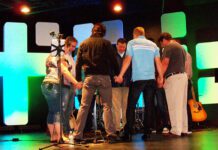The most important dynamic of your setlist isn’t your songs.
It’s more about the fire in your heart, the anticipation in showing up, the wide-eyed wonder of your gaze and bringing others along to do the same.
But there’s a way to craft your setlist that will distract or engage the room.
When crafting a worship set, you want to frame an experience that will stick with people long after the worship service is over. It’s not just about emotional highs, cool music and happy sing-a-longs.
We’re after God’s heart, right?
We want to experience His very near, very real presence.
We want our circumstances to come into alignment with truth. We need a context to cast our cares. We need to be reminded of Who God is, what He has done and what He is planning to do. We need to be reminded who we are in Christ.
My constant prayer is that when the congregation leaves, they’re not so much enraptured by the skill of a band but by the glory of a God like no other.
I want them to bank their hope on the promises of the Word of God that they just finished singing. But we all know there are good songs and bad songs. There are effective worship sets and duds.
While songs aren’t paramount, the songs we choose can unlock faith in the room or they can leave people staring.
And it’s not just the songs themselves, but how we structure a list of songs. It’s how we flow together in worship. And that’s what this article is all about. I want to leave you with five actionable strategies that you can put to use this very day in your worship planning.
5 Simple Strategies for Connecting Worship Songs
I think many of us look to the songs other churches are doing or we look to the CCLI top 10. But we never stop to consider, what does my church really need? Am I giving them what’s trendy or am I serving their voice and native expression of worship?
1. Connect Logical Song Pathways—This is a strategy that has worked really well for me. Rather than trying to find a few isolated songs out of the air, connect the final phrase of your current song with the first phrase of the next. This is a great way for songs to flow in theme and style.
For example, the song “Cornerstone” ends with the phrase “He is Lord, Lord of all,” which logically flows into the chorus of “At Your Name”—“Lord of all the earth, we shout your name.” Or like Chris Tomlin did, “How Great Is Our God” flows very logically into “How Great Thou Art.”
It’s these kind of medleys and song connections that make the truth a little stickier for people. I’m all for the big, isolated song arrangements. But having a “medley moment” in every worship set makes it feel more human and flow more.
2. Harness the Power of Transition Songs—Transitioning from fast to slow can be awkward. Matter of fact, any transition can be awkward. But I’ve found that having a slower, more theologically driven song after a fast song can help drive the theme home.
For example, this last weekend we did “Let It Be Known” from Worship Central, which is a fairly “shallow” theme theologically but still a fun, powerful declaration. As a “transition” song, we sang the old “When I Think About the Lord,” which tied in the whole “shout” and “declare” theme from both songs. It wasn’t a full arrangement, just a simple two-minute transition that helped make the transition smoother (and engaged the older generation).
These simple, transition song moments not only encourage congregational singing, they also give your band a breather before launching into another full arrangement. Give it a try!
3. Look Backward and Forward—Most of us spend a good bit of time looking for great new songs. We listen to CDs, subscribe to Spotify, download on iTunes. We scour YouTube for the latest Hillsong anthems. But what if we put just as much effort into looking back as we do looking forward? What older songs will unlock special moments for your church?
I think every worship set you plan should have this backward/forward dynamic. Learn to be a student of church history and of your church’s history. Capture the deep, wide story of God in your song choices. Resist the urge to just try to be cool.
Bringing back older songs is a great strategy for bringing connection to your setlist.
4. Teach Your Band to Flow—There are specific ways that your band can learn to connect the songs in your set. We don’t just want teams who know how to play songs. We want teams who are there to pastor the music, engage in worship and create a sense of flow. Here are some things to try: If you’re speaking, have your band play behind you to minimize any awkward silence. A light drum groove and lead guitar melody can add a nice effect. Train your band to not “check out” after a song but to be ready for what’s coming next.
For more on this, check out an entire podcast episode we did here.
5. Relax in the Moment—Transitions oftentimes feel awkward because we worship leaders feel awkward. We’re nervous. And what does nervousness do? It breeds more nervousness. We don’t intentionally think through our transitions and approach them with wishful thinking. But what if you decided to relax into those moments in between songs? What if you didn’t rush, didn’t strive, didn’t overspiritualize the moment? What if you were yourself? The more I’ve thought like this, the more I’ve approached those moments with confidence.
Would love to hear from you.
How do you create a sense of flow in your worship sets? How do you pastor people along a journey of worship rather than a bunch of isolated songs?













